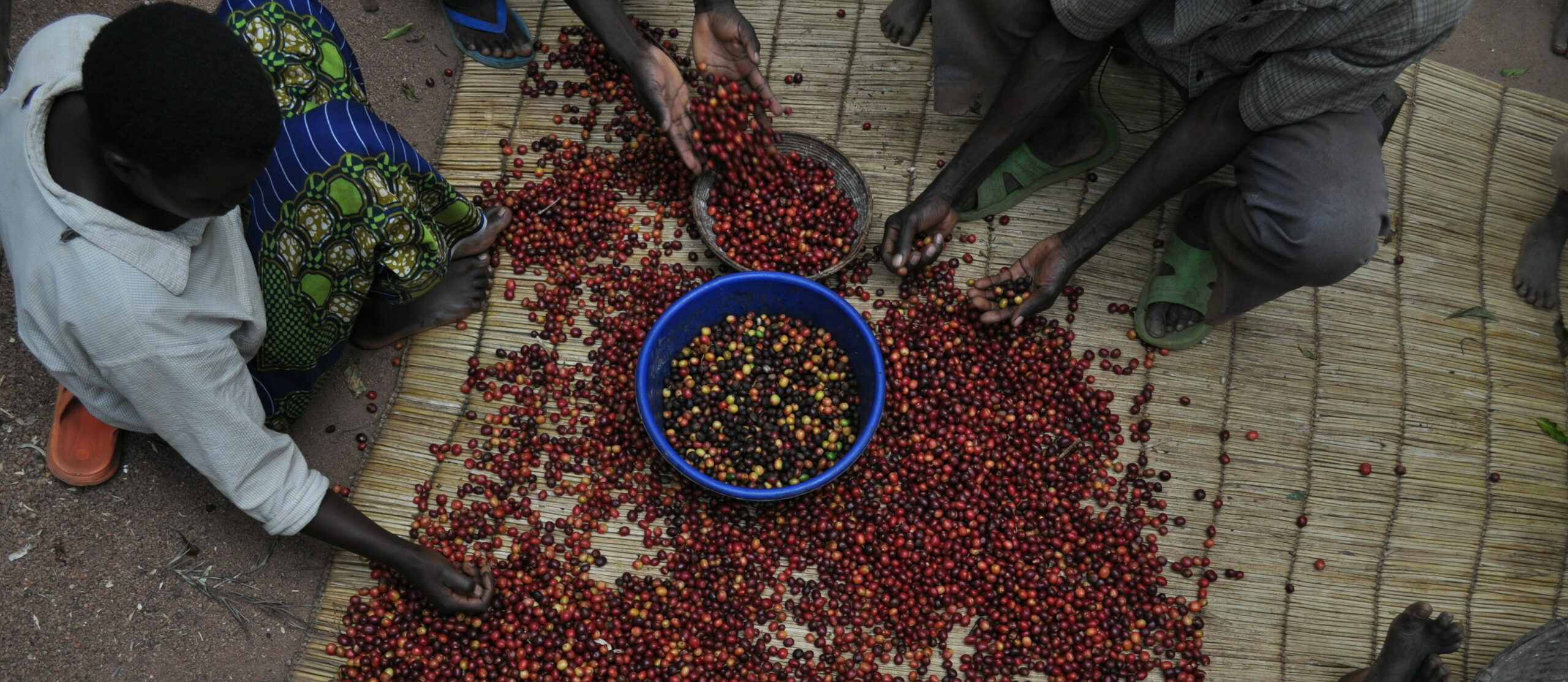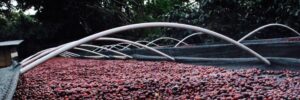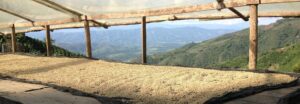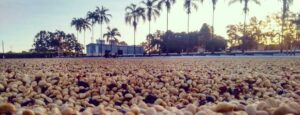
The best practice is to sort ripe fruits from unripe and overripe fruits before processing. This can be done by ‘floating’ coffee cherries. Once the coffee has been harvested, the fruit is taken to the processing facility. Whether that is on their own farm or part of a cooperative is usually based on natural resources readily available. At the processing facility, the coffee fruits are washed and placed in a tank of water. The water will naturally separate the coffee fruits: heavier ripe fruit will sink to the bottom and less dense fruit will float to the surface. Water is a great tool to use for separation of coffee fruits where coffee is mechanically harvested, such as Brazil. In most parts of the world where coffee is grown, however, the ‘sorter’ is a person, who hand picks only the ripe coffee cherries. Every person may have their own preferences with differently processed coffee, and some processes of removing fruit from coffee taste better in particular brewing processes than others. Certain coffee growing regions even have processing methods that are unique to their own region. There are 3 main types of processing: Natural, Washed and Semi-Washed. Once fruit has been sorted, the grower or cooperative will decide whether the fruit will stay on the seed until it is fully dry (natural process), the fruit is removed from the seed entirely then dried (washed process) or part of the fruit is removed from the seed and then is dried (semi-washed). This is the oldest and most traditional, common method of processing, originating where coffee is a native species, Ethiopia. It may be referred to as ‘dry process’ or ‘whole fruit process’ . In this method, the fruit and seed are dried intact, with minimal intervention. Once the seed and fruit are very dry, the fruit is then hulled in a mill, separating the seed from the dried fruit. The natural process is most commonly used in coffee growing regions that have very distinct wet and dry seasons. Most notably the areas of Brazil and Ethiopia rely on the natural process for coffee, as it requires almost no water to process the tonnes of coffee that those countries produce every year. The main disadvantage of using natural process is that it takes around 28 days for the fruit to dry enough to mill. That is 28 days of turning it regularly to make sure it is drying evenly, keeping out pests, making sure that it doesn’t get drenched in a rainstorm, etc. The margin for error is much narrower here. This process also relies heavily on the power of the sun to dry the coffee. More overcast days will lengthen the drying time significantly. It seems like all that care over the drying period, translates into sweetness in the cup. Coffee that has been natural processed, tends to have a higher perceived sweetness, with lots of fruity characteristics in the aroma as well. No one person has acquired scientific reasoning why leaving fruit on the seed leads to a fruitier, sweeter coffee. However, looking at our own experiences with natural coffee, we know that fruity sweet coffee is usually the result. Due to their higher perceived sweetness, natural coffees tend to make a great choice for espresso roasts. In preparing an espresso with a natural coffee roasted for espresso, the sweetness quite often transforms from sweet fruits such as strawberry to chocolate. The mouthfeel might also feel heavier and creamier than when the same coffee is roasted for filter. Some of the coffees in our current offering that are natural processed are the Ethiopia Dumerso and two of the three coffees in the Brazil Collection, Fazenda Recanto Natural and the Bóia Natural Estate Blend. The washed process involves removing the seed entirely from the fruit, using pulping machinery, fermentation and lots and lots of water. Once the seed is free of the fruit, it is dried. Because there is less mass to dry, mechanical drying can be used if there are not a lot of sunny days. The seed will usually be dry within 3-7 days after being washed. The main disadvantage of the washed process is the amount of natural resources that are used. The exact amount of water used to process varies widely, but it is much more than is used in natural and semi-washed process. Innovations have been implemented in some areas to recycle the water used in the washed process. As the washed process utilises a lot of water, it is most commonly used in areas that have steady rainfall throughout the year and in areas that already have large bodies of water close by. However, that is not a hard and fast rule; we are featuring a washed coffee from Brazil in the collection of three coffees, the Fully Washed Estate Blend from Vinhal Artesenais. Some other washed coffees in our current offering are Seleccion Poaquil, Guatemala and La Florida, Colombia. Through removing the fruit entirely before drying, the most common characteristics found in washed coffee are crisp, clean and bright flavours. These may also be perceived as sour or slightly sweet. Washed coffees are pretty versatile in roasting: they make an excellent light, medium, dark or espresso roast. You may also find that it sometimes needs a bit more heat applied to it than a natural coffee. The amount of heat that you apply and for how long is entirely up to you. If you need a starting point for how to decide how you want to roast a coffee, we always provide at least one recommended recipe for filter and one for espresso, with each bag of green coffee that we sell. Semi washed process is where part of the fruit is removed from the seed, through pulping machinery, washing or fermentation, but there is still some left on the seed during the drying. Semi washed process has many different names that all fall under the semi washed category. And there are certain parts of the world that have semi washed processes that are specific to them. You may have heard or seen ‘honey’, ‘pulp natural’, ‘giling basah’ before on a package of coffee; these all fall under the category of semi washed. The advantages of semi-washed are that it uses less water than washed, and it dries quicker than a natural processed coffee. The disadvantages are few; there is a lot of room for experimentation with this process. The room for experimentation as well as the conservative use of natural resources and quicker drying time, have led it to grow in popularity in all coffee producing countries, Brazil in particular, in recent years. In a semi washed coffee, you may expect to find the best characteristics of washed and natural processed coffees. But due to the variance in the process, one semi washed coffee may be sweeter than a washed coffee, whereas another one may have sharper sour notes. This process is a lot less predictable in it’s characteristics. Because of this, these coffees, depending on the variety, are quite versatile and are well suited for filter and espresso. However, it may not be well suited for a very dark roast, as there are so many nuances in the coffee that may be hidden by too much applied heat. Our latest addition to our offerings, Las Mercedes, El Salvador, is a honey processed, ie semi washed coffee. A lot of specialty coffee growers have seen the interest in the market for interesting processes that utilise different technology, machinery, times, temperatures, and other methodology to process the coffees that they are growing. In the last few years, I have tried some really interesting coffees such as the Bóia Natural Estate included in the Brazil Collection. Bóia (pronounced ‘Boy-ya’) in Brazil are called ‘re-passed’ or ‘raisins’ in other parts of the world. Bóia are less dense, partially dried fruit that are scooped off the surface during the floating, before processing begins. These cherries spent the most amount of time on the coffee trees, partially drying from the heat of the sun. Once they have been floated to the surface and scooped up, the coffee then goes through the natural process. The Bóia are set to dry on patios in the sun, being turned frequently until dry enough to be hulled. Once the fruit has been hulled, the coffee seeds are then sorted by density and colour, which ensures that the less dense fruit was not actually defective or unripe, but actually dried ripe fruit. These fruits are beyond ripe, and have long been thought to be ‘defective’ in the coffee industry. However, there is an increasing interest in ‘funky’ and ‘wild’ tasting coffees and the Bóia fits the bill. The advantage of using Bóia is utilising what was once considered waste. It’s also incredibly tasty: expect lots of sweetness! There are lots of ways that producers are continuing to experiment with processing. The possibilities seem endless, even though at the end of it all, processing is simply removing the seed from a fruit. As we know by now, coffee is the seed of a fruit. The fruit skin and sticky mucilage must be removed from the seed in order for the coffee to be roasted. Once coffee is roasted, it is ready to be turned into a warm brown elixir, to be enjoyed and shared with friends and family. How that fruit is removed from the seed of the fruit, will have a large impact on the overall taste and experience of enjoying it. We aim here to show you the differences of these processes, with each of their advantages and disadvantages.
First things first…
Processing
Natural process

Washed

Semi Washed

Experimentation in processing